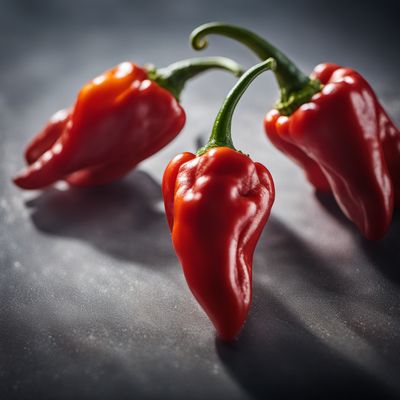
Ingredient
Rocoto capsicum
The Fiery Peruvian Pepper
Rocoto capsicum is a small, round pepper with a vibrant red color and a thick, wrinkled skin. It has a heat level similar to habanero peppers, but with a distinct fruity flavor. The flesh of the rocoto capsicum is crisp and juicy, while the seeds and ribs inside are the spiciest parts. It is commonly used in Peruvian cuisine to add heat and flavor to salsas, ceviches, and stews.
Origins and history
Rocoto capsicum is native to the Andean region of South America, particularly Peru. It has been cultivated and used in Peruvian cuisine for centuries, dating back to the time of the Inca civilization. The rocoto pepper holds cultural significance in Peru and is often featured in traditional dishes such as rocoto relleno, a stuffed pepper dish. It is also grown in other countries with similar climates, including Bolivia and Ecuador.
Nutritional information
Rocoto capsicum is low in calories and a good source of vitamins A and C. It also contains capsaicin, a compound known for its potential health benefits, including pain relief and improved digestion.
Allergens
May contain allergens for individuals sensitive to nightshade vegetables.
How to select
When selecting rocoto capsicum, look for peppers that are firm, with a bright red color and a glossy skin. Avoid peppers with soft spots or wrinkled skin, as they may be past their prime. The size of the pepper does not necessarily indicate its heat level, so it's best to taste a small piece before using it in your dish.
Storage recommendations
Store rocoto capsicum in a cool, dry place, such as the refrigerator. It can be stored whole or chopped, but it's best to remove the seeds and ribs if you prefer a milder flavor. Use within a week for optimal freshness.
How to produce
Rocoto capsicum can be grown in containers or in the ground, as long as it receives plenty of sunlight and warm temperatures. Start by planting seeds indoors and transplanting them outdoors once the weather is consistently warm. Regular watering and fertilization will help the plants thrive.
Preparation tips
To prepare rocoto capsicum, start by cutting off the top and removing the seeds and ribs. If you prefer a milder flavor, soak the pepper in cold water for 30 minutes before using. Rocoto capsicum can be used raw in salsas and ceviches, or cooked in stews, sauces, and stir-fries. Be cautious when handling rocoto capsicum, as the oils can cause skin and eye irritation.
Substitutions
A suitable substitution for rocoto capsicum is habanero pepper, which has a similar heat level and fruity flavor. Alternatively, you can use cayenne pepper or red pepper flakes for a milder option.
Culinary uses
Rocoto capsicum is commonly used in Peruvian cuisine to add heat and flavor to dishes such as rocoto relleno, a stuffed pepper dish, and rocoto salsa. It can also be used in ceviches, stews, sauces, and marinades to add a fiery kick.
Availability
Rocoto capsicum is commonly available in Peru, as well as in other South American countries such as Bolivia and Ecuador. It can also be found in specialty stores or online for international customers.
More ingredients from this category
Recipes using Rocoto capsicum » Browse all

Vietnamese-style Gumbo
Phở-inspired Gumbo: A Fusion of Flavors

Haute Huevos Rancheros
Elevated Mexican Breakfast Delight

Classic Peruvian Ceviche
Zesty Peruvian Delight: Classic Ceviche Recipe

Jain Bisi Bele Bath
Savory Lentil and Rice Medley: Jain Bisi Bele Bath

Mediterranean-style Pho
Mediterranean Fusion: A Twist on Traditional Pho

Fettuccine burro e Parmigiano
Fettuccine with Puerto Rican Flair

Peruvian-style Enchiladas
Andean Enchiladas: A Fusion of Mexican and Peruvian Flavors

Peruvian-style Bibimbap
Inca-inspired Bibimbap: A Fusion of Korean and Peruvian Flavors

Spanish-style Samosas
Tapas-inspired Samosas: A Spanish Twist on a Classic Indian Dish

Hawaiian Coconut Phitti
Tropical Twist: Hawaiian Coconut Phitti - A Taste of Paradise

Molecular Gastronomy Tapas
Revolutionizing Spanish Tapas with Molecular Gastronomy

Daktyla Cantabrian Style
Crispy Cantabrian Delights: Daktyla with a Northern Twist

